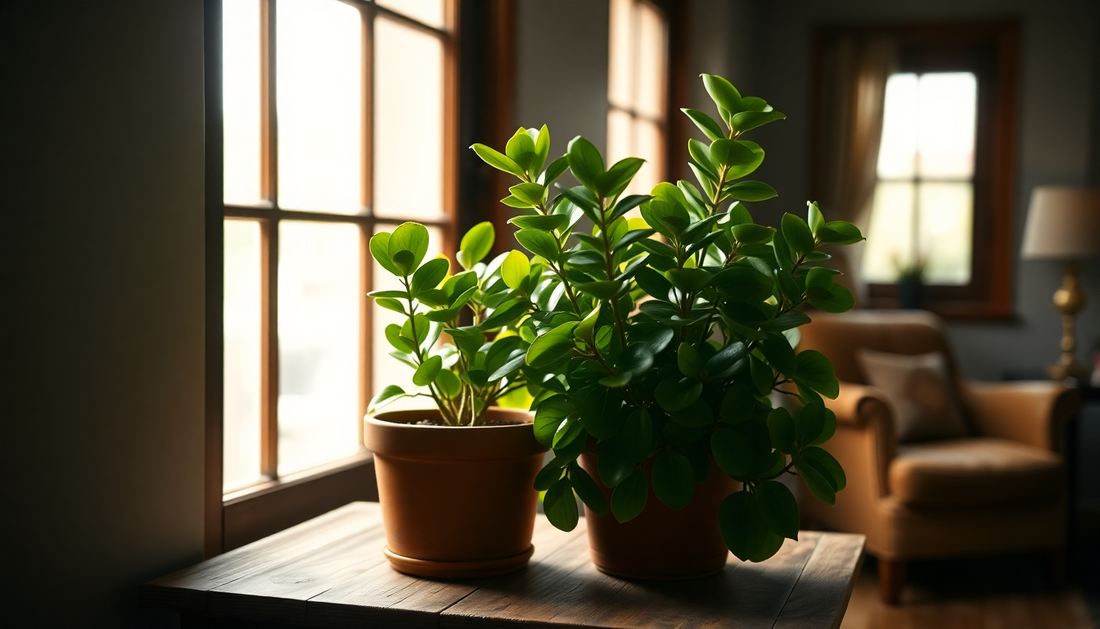
Caring for Your Jade Plant in Low-Light Conditions
Share
As a plant enthusiast, I know the joy of watching a thriving jade plant grace your living space. These resilient succulents are beloved for their thick, glossy leaves and their ability to adapt to a variety of environments. However, one common challenge many jade plant owners face is providing the right amount of sunlight, especially for those living in low-light conditions.
In this comprehensive guide, I'll share my expertise on how to care for your jade plant even when natural sunlight is limited. Whether you're a seasoned plant parent or a newbie to the world of indoor gardening, this post will equip you with the knowledge to help your jade plant thrive.
Understanding Jade Plant's Sunlight Needs
Jade plants, scientifically known as Crassula ovata, are native to South Africa, where they grow in sunny, arid environments. In their natural habitat, these plants are accustomed to receiving ample sunlight throughout the day. However, when grown indoors or in areas with limited natural light, they can still flourish with the right care and attention.
Jade plants are considered to be moderately light-demanding, meaning they require a good amount of sunlight to maintain their health and vibrant appearance. Ideally, they should receive at least 4-6 hours of direct sunlight per day. Without sufficient light, jade plants may start to etiolate, or stretch and become leggy, in an attempt to reach for the nearest light source.
Choosing the Right Spot for Your Jade Plant
When it comes to low-light conditions, the placement of your jade plant is crucial. Here are some tips to help you find the best spot in your home or office:
Bright Indirect Light
Look for a spot that receives bright, indirect sunlight. This could be a spot near a south- or west-facing window, where the sunlight is filtered through sheer curtains or blinds. Avoid placing your jade plant in direct sunlight, as this can scorch the leaves and cause them to turn yellow or brown.
Rotate Regularly
If your jade plant is situated in a spot that only receives partial sunlight, be sure to rotate it regularly to ensure even growth. This will help the plant receive adequate light on all sides and prevent it from becoming lopsided.
Consider Artificial Lighting
If your home or office lacks sufficient natural light, you can supplement with artificial lighting. LED or fluorescent grow lights can be a great solution, providing the necessary light for your jade plant to thrive. Position the light source about 6-12 inches above the plant and leave it on for 12-14 hours per day.
Watering and Soil Requirements
Proper watering and soil selection are also crucial for the well-being of your jade plant, especially in low-light conditions.
Watering Schedule
Jade plants are known for their drought-tolerance, but they still require regular watering. In low-light conditions, the soil may take longer to dry out, so it's important to adjust your watering schedule accordingly. As a general rule, allow the soil to partially dry out between waterings, and then water thoroughly, making sure the excess water can drain out of the pot.
Soil Composition
Jade plants prefer well-draining, sandy soil that is slightly acidic, with a pH between 6.0 and 6.5. A potting mix specifically formulated for succulents or cacti is an excellent choice, as it will provide the necessary drainage and nutrient balance for your jade plant.
Pruning and Propagation
Proper pruning and propagation techniques can also help your jade plant thrive in low-light conditions.
Pruning
Regularly pruning your jade plant can encourage bushier growth and prevent it from becoming leggy. Focus on removing any dead, damaged, or overly long stems, and use clean, sharp pruning shears to make clean cuts.
Propagation
Jade plants are relatively easy to propagate, and this can be a great way to create new plants or fill in any gaps in your existing jade plant. Take stem cuttings, allow them to callus over, and then plant them in well-draining soil. With the right care, these cuttings will root and develop into new, healthy jade plants.
Troubleshooting Common Issues
Even with the best care, your jade plant may encounter some challenges in low-light conditions. Here are a few common issues and how to address them:
Etiolation
If your jade plant starts to stretch and become leggy, it's a sign that it's not receiving enough light. Move the plant to a brighter location or supplement with artificial lighting.
Leaf Discoloration
Jade plant leaves that turn yellow, brown, or develop spots may be a sign of overwatering, underwatering, or nutrient deficiencies. Adjust your watering schedule and check the soil's pH and nutrient levels.
Pests
Jade plants can be susceptible to common houseplant pests, such as mealybugs or scale insects. Regularly inspect your plant and address any infestations promptly to prevent further damage.
By following these tips and techniques, you can successfully care for your jade plant in low-light conditions and enjoy its beautiful, lush foliage for years to come. Remember, patience and consistent care are key to helping your jade plant thrive, even in less-than-ideal lighting situations.
Conclusion
Caring for a jade plant in low-light conditions may require a bit more effort, but the rewards are well worth it. With the right placement, watering schedule, and pruning techniques, you can help your jade plant flourish and bring a touch of natural beauty to your indoor space.
Whether you're a seasoned plant enthusiast or just starting your indoor gardening journey, I hope this guide has provided you with the knowledge and confidence to care for your jade plant and watch it grow and thrive, even in the most challenging of lighting conditions.
Happy planting!
